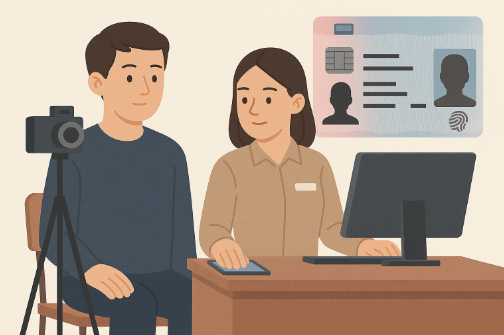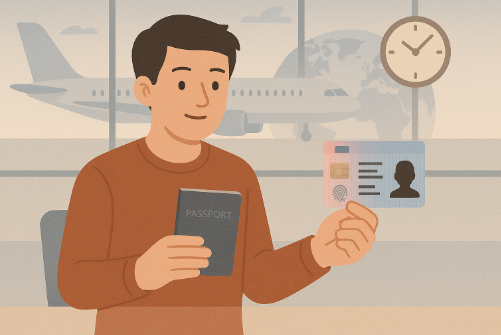Introduction
The UK Home Office issues formal documents called Biometric Residence Permits. It confirms an individual’s identity, immigration status, and entitlements such as the right to work, study, or access public services. The BRP enhances security by replacing older paper-based forms of immigration documentation. Although the UK is now transitioning to eVisas (a digital alternative), understanding how BRPs work remains crucial for anyone who holds or has held one.
What Is a Biometric Residence Permit (BRP)?
A BRP is a credit card-sized document issued to foreign nationals in the UK. It includes:
- Full legal name of the holder
- Date and place of birth
- Biometric data, including a facial image and fingerprints
- Immigration status and conditions (e.g., permission to work or study)
- National Insurance number (if issued by the Home Office)
This card acts as a secure form of ID and confirms a person’s legal residency and rights in the UK.
Who gets a biometric residence permit?
You will be issued a BRP if you:
- Make an application to remain in the UK for longer than 6 months.
- Extend your current UK visa
- Apply for Indefinite Leave to Remain (ILR)
- Request a transfer of visa to a new passport
- Apply for certain Home Office travel documents (e.g., for refugees or stateless persons)
You can demonstrate your eligibility to live, work, or study in the UK thanks to the BRP.
What is the difference between residence permit and biometric residence permit?
| Type of Permit | Description |
|---|---|
| Residence Permit | A general term used in various countries for documentation proving legal stay. |
| Biometric Residence Permit | Specific to the UK, includes: – Embedded biometric data for security – Used as secure proof of identity – Grants access to employment, housing, and healthcare – Accepted as valid ID for services, including banking |
How Much Does It Cost to Get a BRP?

Costs associated with BRPs include:
- Initial BRP issuance: Free with your approved visa or immigration application
- Lost or stolen BRP replacement:
- Standard application: £19
- Super-priority service: up to £75
- Biometric enrolment fee (if required): around £19.20
To prevent legal repercussions, report a lost or stolen BRP as soon as you can.
Apply for biometric card online
You do not need to apply for a BRP separately when applying for a visa. However, do the following actions if you need to replace a BRP that has been misplaced, stolen, or damaged:
- Go to the official UK government BRP page
- Complete the online application form
- Pay the required fee
- Book and attend a biometric appointment if instructed
- After approval, you should get your new BRP by postal mail in 7–10 working days.
Biometric residence permit number
Your BRP card has a unique Biometric Residence Permit number, which:
- Is found on the front of the card
- Contains 9 alphanumeric characters (e.g., RML123456)
- Is essential for:
- Creating a UKVI account for eVisa access
- Verifying your status with employers or landlords
- Replacing or updating your BRP
Who needed a biometric residence permit in the UK?
BRPs were issued to:
- Migrants staying in the UK for more than 6 months
- Visa extension or transfer applicants
- Asylum seekers and those granted humanitarian protection
- Dependants of students, skilled workers, or other long-term migrants
Short-term visa holders (less than 6 months) and most visitors were not issued a BRP.
How Was a Biometric Residence Permit Issued or Obtained?

Application and delivery process
- No separate application required: Issued automatically upon approval of immigration application
- Inside the UK: Sent via courier within 7–10 working days
- Outside the UK: Collected within ten days of arrival from the assigned Post Office branch.
Security features and design
- Made of tamper-resistant polycarbonate
- Includes an embedded microchip storing biometric data
Contains:
-
- Holographic images
- Optically variable ink (OVI)
- Machine-readable zone (MRZ)
- Tactile printing to prevent forgery
When did the transition from BRPs to eVisas begin?
- April 2024: UK Home Office began inviting BRP holders to register for a UKVI account
- November 2024: New visa applicants started receiving eVisas instead of BRPs
- December 2024: Deadline set for BRP expiry; transition extended into 2025 for remaining users
What Grace Periods Allowed Continued Use of BRPs for Travel?

- BRPs were valid for entry and travel until 1 June 2025
- From 2 June 2025, BRPs cannot be used for border entry or as a travel document
Are expired BRPs still usable within the UK?
Even after expiry:
- You may register for a UKVI account using your BRP.
- It can generate share codes for employers and landlords
- It cannot be used for international travel or as official ID
What happens if you have indefinite leave to remain (ILR)?
- As of 31 October 2024, BRP holders with ILR or ILE must apply for a No Time Limit (NTL) update to receive an eVisa
- Those without a digital immigration record must act promptly to maintain valid documentation
What has changed? Transition from BRP to eVisa (UK rules updated)
Key changes include:
- All BRPs expire on 31 December 2024, regardless of visa validity
- eVisas now serve as the primary method of verifying UK immigration status
- To obtain digital status, users need to register for a UKVI account.
- Transition is free of charge and doesn’t affect existing rights or permissions
What Are the Practical Uses and Importance of BRPs (and eVisas)?
With BRPs:
- Use as proof of:
- Right to work
- Right to rent
- Access to healthcare and benefits
- Identity for public services
- Required for applying to:
- Employers
- Landlords
- National Health Service
- Educational institutions
With eVisas:
- You may check your immigration status online using your UKVI account.
- Share codes replace physical document checks
- No need to carry physical ID for immigration verification
What risks or issues arose during the transition to eVisas?
- System errors and outages at airports and borders
- Some government agencies and employers still do not recognise eVisas as valid ID
- Millions unaware of the need to switch before BRP expiry
- Digital access issues for vulnerable groups (elderly, disabled, low-tech users)
- Privacy and cybersecurity concerns over sensitive data storage
How many people have made the switch to eVisas?
- By April 2025, more than 4.3 million individuals had registered for UKVI accounts
- As of June 2025, approximately 300,000 people still had not registered
What’s the Difference Between a Visa and a BRP?
| Feature | BRP (Biometric Residence Permit) | eVisa (Digital Immigration Status) |
| Format | Physical card | Digital-only system |
| Biometric Data | Stored on chip | Stored digitally by UKVI |
| Validity | Expired by 31 Dec 2024 | Valid while immigration status remains |
| Access | Present card | Log in to UKVI account |
| Usage | ID, work, rent, public services | Share code for work, rent, NHS, etc. |
| Transition Required | Yes | Yes |
Conclusion
Verifying identification and immigration status in the UK has been made possible in large part by the Biometric Residence Permit. But since the UK has switched to a completely digital immigration procedure, setting up a UKVI account and activating your eVisa are crucial. This will guarantee continuous access to jobs, housing, and medical care.
Stay informed and act before deadlines to avoid disruptions.
FAQs
1. What happens if my BRP has expired but I still have valid immigration permission?
You must create a UKVI account and access your eVisa. Your rights remain unchanged.
2. Can I still travel using my BRP?
No. As of June 2025, travel using a BRP is no longer valid.
3. How do I prove my right to work without a BRP?
Use the UKVI share code via your eVisa to provide proof.
4. What should I do if I can’t create a UKVI account?
Contact UKVI support. Assistance is available, especially for the elderly or disabled.
5. Why did the UK replace BRPs with eVisas?
To reduce fraud, increase efficiency, and streamline immigration checks.

I’m Adam Milne, a business writer and co-author at UKBusinessMag.co.uk. I’m passionate about simplifying complex topics—whether it’s tax, startup strategy, or digital marketing—so that entrepreneurs can take action with confidence. With years of experience in small business consultancy, I bring a practical perspective to every piece I write, helping readers turn ideas into results.



